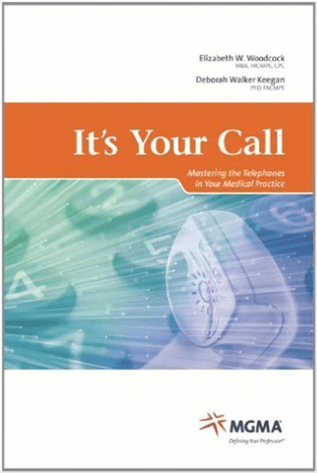
Book Review – It’s Your Call: Mastering the Telephones in Your Medical Practice by Elizabeth W. Woodcock MBA, FACMPE, CPC and Deborah Walker Keegan Ph.D., FACMPE. Published by MGMA
It is easy for phone service to feel overwhelming. The key in mastering the telephones is to control the telephone process, instead of letting the process control you. Woodcock and Keegan offer a wealth of tips and process ideas in It’s Your Call, a fantastic reference work for improving phone operations in your practice.
In a world where customer service is king and social media has led to a culture of almost instantaneous responses, the telephone remains a primary contact method. For the foreseeable future, it will be a growing part of your medical practice.
The authors cover the following material
|
 |
One of the best aspects of It’s Your Call has to be the “Best Practices” sprinkled generously throughout the book. Things like, “Call volumes can be reduced to twice your visits,” and “Hire staff with excellent customer service backgrounds and then train for medical terminology and medical practice operations.”
The authors were kind enough to include samples of documents that can be used for measurement and streamlining current processes or establishing new procedures more efficiently. Highlighting the most crucial points in text boxes and bold print makes it easy to locate key points and guides readers to the biggest takeaways from a content rich book.
What’s Missing
The book is not without its flaws and blind spots, however, and here are the ones I found most glaring.
- Clinical calls are crucial
Physician calls tend to be the most expensive, time intensive of all telephone contacts in a practice yet there was very little discussion of ways to improve efficiency of these calls. Despite heavy discussion on the cost of callback, there is essentially no discussion on the most expensive calls and how to reduce those costs.
- Major Metrics
The tables and diagrams in “Measure Your Telephone Calls” are neat and tidy with regard to measurements, statistics, and documentation. However, the three most important key metrics are notably absent – first call resolution, mean time to resolution, and patient satisfaction.
- First call resolution
Handling issues on a patient’s first call is crucial to improving not only the bottom line, but also customer satisfaction. How many times do you want to call for assistance before you receive the answer you need? Whether you utilize low-tech solutions like paper and pen or high-tech tracking software like Healthdesk, it is crucial that you monitor first call resolution statistics.
- Mean time to resolution
If you call and leave a message, how long do you wait for a return call before you call again? Tracking the amount of time it takes to respond to a patient message can help you identify lag times that can be improved.
- Patient satisfaction
Do happy patients leave practices? Do unhappy patients stay where they don’t feel valued? No and no, so keeping your patients satisfied remains an important part of your practice’s success. Trying brief exit surveys, web-based surveys, or immediate options via phone or email systems can provide you with the information you need to gauge how effective your staff is with regard to patient satisfaction.
- First call resolution
- Missing Change Management
Though briefly addressed, change management is not discussed in enough detail to provide effective solutions. A change management chapter would greatly help the practice administrators who are the ones typically tasked to drive improvements.
- Start at the top – with data
Gather as much data as possible to make your case for change and share it with management.
- Find champions
Many practices have at least one provider and a handful of nurses who really care about improving service. Make them your allies.
- Engage every level in goal setting and implementation
How is your team really doing? How do you best use the information you’ve obtained? It’s imperative to find a baseline and identify where you want to make improvements.
- Identify low hanging fruit
Hiring new staff or buying new technology may be the answer, but not the place to start. Try altering workflow in smaller ways to alleviate some of your areas of concern.
- Start at the top – with data
- Emphasis on some high price, time-intensive options
The authors advocated social media as an education and communication solution. Social media is the way of the world these days, but it is constantly changing which means continuous training and updates for your team as well as the need for appropriate tech to use the platforms. While YouTube and other social media outlets could be a boon, without appropriate tech and training it could just as easily be a bust.
- Light on the real world applications
There are a few case studies included that provided insight into real world problems but there were not enough to have the impact It’s Your Call could have had. There is something about that real world application, that relatability of the “that’s happening to me” moment. Capitalizing on more case studies could have rounded out the content a bit more.
- Callback or not? Confusing recommendations
Woodcock and Keegan recommend transitioning inbound calls to a message + outbound call workflow. But then they also frequently quote the statistic that each message costs $15. This leaves the reader without a clear guideline for when and why to pursue outbound calls versus when to avoid them.
I understand the reason for this confusion. There is a trade-off with outbound calls that is a little technical to navigate. Taking messages and calling patients back has the benefit of being asynchronous. The patient doesn’t have to be assisted at that exact moment. In a world of call volumes that really spike, parking some calls for later really helps ease the pressure off the telephone staff and reduce the queues by letting them catch up on these calls when the volume is lower.The tradeoff is that retrieving messages and calling patients back, often with phone tag, normally takes a lot longer than it would have to resolve the issue at the moment. So you buy yourself some time to handle issues at slower times at the cost of taking longer per issue to do so. I would have liked Woodcock and Keegan to provide some guidance around this trade-off.
Why it’s Worth the Read
- Measuring your efficiency
It’s Your Call emphasizes the need to measure the efficiency of current procedures and data received from test calls to your practice to determine the overall effectiveness as well as areas for improvement. Further, practices are encouraged to include scheduling in your statistics (reschedules, cancelled appointments, missed appointments, etc.) to make certain no areas for potential improvement are missed.
- Convert anecdotes to data – don’t miss out on this crucial performance data.
- Measure reasons for calls, phone quality, and determine inbound call volume.
- Create phone expectation and share them with all staff.
- Try out some Mystery Patient Surveys and Patient Advisory Groups
- Educating your patients
Additionally, It’s Your Call discusses the need for patient education and suggests the best ways (hooray for Best Practices!) to reduce calls by providing appropriate information both verbally and in written form. Did you know that people only recall a small portion of what they hear? The amount of information retained from verbal instruction decreases when the individual is under stress. It stands to reason that providing your patient with written instructions to supplement verbal input gives them the option to review the information when they have clearer heads.
- Utilize all staff
It may benefit your bottom line to consider alternative systems that utilize your non-clinical staff. Breaking from traditional procedures for handling things like prescription refills can increase your overall efficiency. A good tip here is to hire staff with solid, even strong, customer service backgrounds and then train them on the medical aspects.
- Be proactive
When can you call the patient first? Take a hard look at opportunities to reach out to your patient before they call in to ask a question. One suggestion was to address time frames discussed with patients. If you believe test results will be back within twenty-four hours tell the patient you will let them know in two to three days. This provides an opportunity to account for delays and reach out to the patient before they call in.
- Do it right the first time
Reworking is not productive. Arrange time for physicians to handle calls every day so they can handle things that need to be addressed and avoid phone tag between staff and patients. Have front line staff attempt to solve any of the patient’s issues before passing them on, they might be able to prevent a transfer altogether with a simple “Is there anything I can help you with?”
Beginning with the basics of measuring and evaluating the effectiveness of your current system, It’s Your Call examines the behind the scenes strategies that can help improve your main line of customer service and ultimately your bottom line. The authors really nail down the most effective management techniques and how to properly train your staff and implement any changes as seamlessly as possible. There is even a healthy discussion on selecting the proper phone system and lengthy chapter on call centers as an option.
It’s Your Call is a wonderful resource and guide from MGMA that breaks down some of the more crucial aspects of phone systems and procedures into simple terms while providing a wealth of Best Practice tips. It may not answer all of your questions or solve all of your issues, but it can set you on the right path.
Posted By

Stephen Dean is COO of Keona Health, where he’s spent 13 years building AI systems that transform patient access. Before “agentic AI” was a term, his team was deploying autonomous systems that now handle millions of patient conversations annually.
Related Post
November 19, 2024
heading into 2025, healthcare organizations face increasing pressure to digitize...
October 18, 2023
is your healthcare call center getting crushed under the weight of frustrated...


